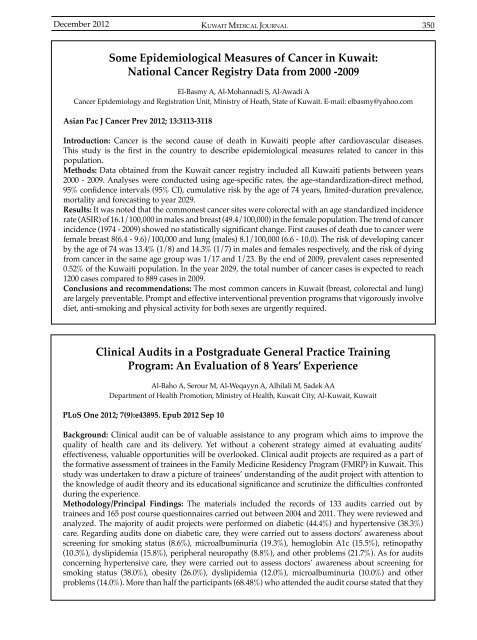Vol 44 # 4 December 2012 - Kma.org.kw
Vol 44 # 4 December 2012 - Kma.org.kw
Vol 44 # 4 December 2012 - Kma.org.kw
Create successful ePaper yourself
Turn your PDF publications into a flip-book with our unique Google optimized e-Paper software.
<strong>December</strong> <strong>2012</strong><br />
KUWAIT MEDICAL JOURNAL 350<br />
Some Epidemiological Measures of Cancer in Kuwait:<br />
National Cancer Registry Data from 2000 -2009<br />
El-Basmy A, Al-Mohannadi S, Al-Awadi A<br />
Cancer Epidemiology and Registration Unit, Ministry of Heath, State of Kuwait. E-mail: elbasmy@yahoo.com<br />
Asian Pac J Cancer Prev <strong>2012</strong>; 13:3113-3118<br />
Introduction: Cancer is the second cause of death in Kuwaiti people after cardiovascular diseases.<br />
This study is the first in the country to describe epidemiological measures related to cancer in this<br />
population.<br />
Methods: Data obtained from the Kuwait cancer registry included all Kuwaiti patients between years<br />
2000 - 2009. Analyses were conducted using age-specific rates, the age-standardization-direct method,<br />
95% confidence intervals (95% CI), cumulative risk by the age of 74 years, limited-duration prevalence,<br />
mortality and forecasting to year 2029.<br />
Results: It was noted that the commonest cancer sites were colorectal with an age standardized incidence<br />
rate (ASIR) of 16.1/100,000 in males and breast (49.4/100,000) in the female population. The trend of cancer<br />
incidence (1974 - 2009) showed no statistically significant change. First causes of death due to cancer were<br />
female breast 8(6.4 - 9.6)/100,000 and lung (males) 8.1/100,000 (6.6 - 10.0). The risk of developing cancer<br />
by the age of 74 was 13.4% (1/8) and 14.3% (1/7) in males and females respectively, and the risk of dying<br />
from cancer in the same age group was 1/17 and 1/23. By the end of 2009, prevalent cases represented<br />
0.52% of the Kuwaiti population. In the year 2029, the total number of cancer cases is expected to reach<br />
1200 cases compared to 889 cases in 2009.<br />
Conclusions and recommendations: The most common cancers in Kuwait (breast, colorectal and lung)<br />
are largely preventable. Prompt and effective interventional prevention programs that vigorously involve<br />
diet, anti-smoking and physical activity for both sexes are urgently required.<br />
Clinical Audits in a Postgraduate General Practice Training<br />
Program: An Evaluation of 8 Years’ Experience<br />
Al-Baho A, Serour M, Al-Weqayyn A, Alhilali M, Sadek AA<br />
Department of Health Promotion, Ministry of Health, Kuwait City, Al-Kuwait, Kuwait<br />
PLoS One <strong>2012</strong>; 7(9):e43895. Epub <strong>2012</strong> Sep 10<br />
Background: Clinical audit can be of valuable assistance to any program which aims to improve the<br />
quality of health care and its delivery. Yet without a coherent strategy aimed at evaluating audits’<br />
effectiveness, valuable opportunities will be overlooked. Clinical audit projects are required as a part of<br />
the formative assessment of trainees in the Family Medicine Residency Program (FMRP) in Kuwait. This<br />
study was undertaken to draw a picture of trainees’ understanding of the audit project with attention to<br />
the knowledge of audit theory and its educational significance and scrutinize the difficulties confronted<br />
during the experience.<br />
Methodology/Principal Findings: The materials included the records of 133 audits carried out by<br />
trainees and 165 post course questionnaires carried out between 2004 and 2011. They were reviewed and<br />
analyzed. The majority of audit projects were performed on diabetic (<strong>44</strong>.4%) and hypertensive (38.3%)<br />
care. Regarding audits done on diabetic care, they were carried out to assess doctors’ awareness about<br />
screening for smoking status (8.6%), microalbuminuria (19.3%), hemoglobin A1c (15.5%), retinopathy<br />
(10.3%), dyslipidemia (15.8%), peripheral neuropathy (8.8%), and other problems (21.7%). As for audits<br />
concerning hypertensive care, they were carried out to assess doctors’ awareness about screening for<br />
smoking status (38.0%), obesity (26.0%), dyslipidemia (12.0%), microalbuminuria (10.0%) and other<br />
problems (14.0%). More than half the participants (68.48%) who attended the audit course stated that they
















